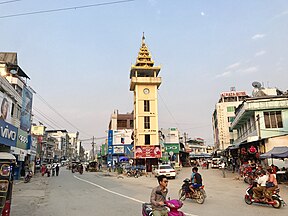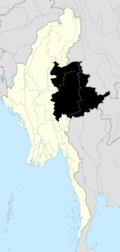Muse, Myanmar
Muse
မူဆယ်မြို့ (ဝဵင်းမူႇေၸႊ) | |
|---|---|
Town | |
Skyline in 2010 Downtown Muse | |
| Coordinates: 23°58′45″N 97°54′17″E / 23.97917°N 97.90472°E | |
| Country | |
| State | |
| District | Mu Se District |
| Township | Mu Se Township |
| Population (2014) | 165,022[1] |
| • Religions | Buddhism Islam Christianity |
| Time zone | UTC+6.30 (MMT) |
Muse (Burmese: မူဆယ်မြို့; MLCTS: mu hcai mrui.; Shan: မူႇၸေႊ) is the capital of Mu Se Township (also spelled as Muse Township) in northern Shan State, Myanmar. It is a border town situated on the Shweli River (Nam Mao), and is connected by a bridge to Ruili (Shweli, [ʃwèlì], in Burmese) in Yunnan Province, China.[2][3][4] The town is a major regional trade hub with China, accounting for 70% of cross-border trade between the two nations.[5]
History
[edit]The old bridge in Muse, dubbed the "Gun Bridge" by locals in reference to the frequency of illegal armaments trafficking through the bridge, was closed in 2005, replaced by a wider bridge parallel to it.[4]
In 2014, the governments of Myanmar and China have been discussing a border dispute in the area of Namkham and Muse.[6]

On May 23, 2021, the People's Defense Force, the armed forces of the National Unity Government, clashed with Tatmadaw forces in Muse, killing 13 security guards.[7]
During Operation 1027, the Three Brotherhood Alliance began clashing with the Tatmadaw over control of Muse. The main resistance from the Tatmadaw is located at its 105th tactical command base, located on a hill east of Muse in Mong-Yu.[5] However, the city proper remains under full Tadmadaw control.[8]
Transport
[edit]Muse is today connected to Mandalay via Lashio by the National Highway 3 450 km Asian Highway route 14 (AH14),[9] The old Burma Road links the new road to Bhamo in Kachin State which links to the Ledo Road.[10] Mandalay-Lashio-Muse Road included part of the Burma Road and was rebuilt and upgraded for heavy traffic in 1998 on a Build-Operate-Transfer basis (BOT) by the Asia World Company headed by the son of the former opium warlord Lo Hsing Han. It has cut the journey time from 2 days, even a week in the rainy season, to just 12–16 hours.[11] Muse is also connected to central Burma via the Mandalay–Lashio Railway.[12]
Economy
[edit]Muse is home to one of 5 official border trade posts with China, and opened on 21 January 1998.[13] In 2022, the trade volume at the border post stood at US$2.099 billion.[14] Cross-border trade was banned by Ne Win after the military came to power in Burma in 1962 but the ban was lifted following negotiations in 1988. Bilateral trade has risen steadily since, increasing by 60% in the fiscal year ending 31 March 2008, and constitutes 24% of Burma's trade ranking China as a major trading partner second only to Thailand.[15]
Burma exports mainly raw materials such as agricultural produce, fish, timber, gems and minerals, and imports consumer goods, electronics, machinery and processed food.[15][16][17] Muse's '105th mile Trade Zone', a border zone of 150 hectares, opened in April 2006, the first and largest border trade camp of its kind in Burma, handling as much as 70% of cross border trade with China. A trade fair has been held annually every December since 2001 alternating between the two border towns each year with India, Bangladesh and Thailand as well as China taking part.[18]
In 2007 the local militia, under orders of the military authorities, seized 10,000 acres (40 km2) of land in the area, mainly tea and orange plantations as well as small farms, with little or no compensation, in a drive to cultivate physic nuts for biodiesel as an alternative fuel.[19][20]
On 8 May 2008, the military seized 20 truckloads of biscuits and other goods at Muse allegedly for the relief of Cyclone Nargis victims.[21]
A joint enterprise between Burma and China to construct oil and gas pipelines from the Bay of Bengal via Mandalay through Muse to Kunming in Yunnan Province starts operations in 2009.[22]
Narcotics
[edit]Recently China built a 4 km (2.5 mi) long fence on the border near Ruili in order to stop drug trafficking and two more are under construction.[15] Drug addiction is a major problem in the area.[23][24] The opium poppy harvest had increased since Lo Hsing Han managed to rebuild his drug empire after becoming the intermediary for cease-fire agreements between the military intelligence chief Khin Nyunt and the Kokang and Wa insurgents who had rebelled against and toppled the Communist leadership in 1989.[25] The World Food Program carried out emergency food assistance to former poppy farmers in 2004-2005 as pressure mounted to stop cultivation of the poppy.[26]
Gambling, drugs and prostitution flourished in Ruili, but Muse's own efforts to share in the Las Vegas style business atmosphere met with much less success. The Chinese authorities cracked down on heroin entering - but not the chemical ingredients for the amphetamine-type stimulant (ATS) called yaba leaving - and also on Chinese men enjoying the same pleasures on the Burmese side of the border.[citation needed] Besides the UNODC, a number of groups and organisations such as the Asian Harm Reduction Network (AHRN) and Buddhist monks are also involved in the amelioration of the HIV/AIDS problem among drug users.[27][28]
Notes
[edit]- ^ "Muse (Township, Myanmar)". Citypopulation.de. Retrieved 4 August 2024.
- ^ "Burma Road". National Geographic Magazine, July 1995. Retrieved 2008-10-25.
- ^ Mansfield, Stephen. "Myanmar's Chinese Connection". The Japan Times, May 13, 1999. Retrieved 2008-10-25.
- ^ a b Fullbrook, David. "Inland China's route to prosperity". Asia Times Sep 30, 2006. Archived from the original on 2006-10-19. Retrieved 2008-10-25.
{{cite news}}: CS1 maint: unfit URL (link) - ^ a b Reh, Saw (15 December 2023). "Battle For Main Trade Zone on Myanmar's Border With China Continues to Rage". The Irrawaddy. Retrieved 17 December 2023.
- ^ Nyein Nyein Govt Working With China on Border Dispute in Shan State
- ^ "Myanmar: 13 security forces members killed in clash with anti-coup bloc's defence force". ANI News. 24 May 2021. Retrieved 26 May 2021.
- ^ "Myanmar Ethnic Alliance Continues Gains, Despite China-Brokered Ceasefire". thediplomat.com. Retrieved 2024-02-27.
- ^ "Asian Highway in Myanmar" (PDF). unescap.org. Retrieved 2009-01-01.
- ^ Win Nyunt Lwin. "Historic road links wilderness and culture". Myanmar Times October 4–10, 2004. Archived from the original on 2008-10-06. Retrieved 2009-01-01.
- ^ Toshihiro Kudo (2008). "Dictatorship, disorder and decline in Myanmar, Chapter 6 - Myanmar's economic relations with China: who benefits and who pays?" (PDF). Australian National University. Retrieved 2009-01-01.
- ^ "Train travel in Myanmar(Burma)". seat61.com. Retrieved 2009-01-01.
- ^ "Border Trade Posts". Ministry of Commerce. Retrieved 2023-03-05.
- ^ "Border Trade Data". Ministry of Commerce. 2023-02-24. Retrieved 2023-03-05.
- ^ a b c Wai Moe. "China Builds Fence on Part of Burma's Kachin Border". The Irrawaddy December 23, 2008. Retrieved 2008-12-25.
- ^ "Myanmar to export 200,000 tons of maize grain to China next year". China View 2008-12-25. Archived from the original on October 23, 2012. Retrieved 2009-01-01.
- ^ Sann Oo. "Too many eels create slippery export issue". Myanmar Times July 30 - August 5, 2007. Archived from the original on July 16, 2011. Retrieved 2009-01-01.
- ^ "Growing Sino-Myanmar trade contributes much to regional development and transport improvement Myanmar-China Trade Fair opened in Muse, Shan State (North)". New Light of Myanmar 20 December 2006. Archived from the original on 23 September 2007. Retrieved 2008-12-31.
- ^ Khun Sam. "Militia Seizes Land in Shan State for Physic Nut Crops". The Irrawaddy June 11, 2007. Archived from the original on August 12, 2010. Retrieved 2008-12-31.
- ^ "Myanmar to produce bio-diesel from jatropha curcas". MRTV3. Archived from the original on 2011-07-19. Retrieved 2009-01-01.
- ^ "Aid to Burma: only on the regime's terms" (PDF). Shan Women’s Action Network Newsletter,October 2008. Archived from the original (PDF) on 2011-10-04. Retrieved 2009-01-01.
- ^ Eric Watkins (2008-11-20). "Myanmar awards China pipeline rights". Oil&Gas Journal. Retrieved 2009-01-01.
- ^ "Strategic Programme Framework: Union of Myanmar 2004-2007" (PDF). United Nations Office on Drugs and Crime. Retrieved 2009-01-01.
- ^ "Community-run rehab centers in the north". Shan Herald Agency for News (SHAN). Archived from the original on 2009-02-11. Retrieved 2009-01-01.
- ^ Bertil Lintner. "The Golden Triangle Opium Trade: An Overview" (PDF). Asia Pacific Media Services, March 2000. Retrieved 2009-01-04.
- ^ "EMOP 10345.0: Emergency Food Assistance to Ex-Poppy Farmers in Northern Shan State, Myanmar" (PDF). WFP. Archived from the original (PDF) on 2005-05-21. Retrieved 2009-01-01.
- ^ "Fund for HIV/AIDS in Myanmar (FHAM)". Asian Harm Reduction Network (AHRN). Retrieved 2009-01-01.
- ^ "HIV/AIDS education and training in Yunnan, China and the Shan State, Burma - By The Sangha Metta Project, November 2000". buddhanet.net. Retrieved 2009-01-01.
External links
[edit]- Muse, bridge over Shweli, and Ruili WikiMapia
- Kyegaung checkpoint, Myanmar-China border at Muse-Ruili Asterism
- Shan State map: 1 = Muse, I = Ruili Asterism
- Photo of the "Gun Bridge" over the Shweli Renaud Egreteau
- Mandalay-Lashio-Muse Union Highway MRTV3 video
- Fifth Destruction of Seized Narcotic Drugs, March 21, 2005 Ministry of Foreign Affairs
- 2008 Myanmar-China border trade fair (Muse) Department of Border Trade
- Htoo Trading; only company with timber export license illegal-logging.info, 17 August 2006
- Shan: Rare Tree Trade Aggravates Deforestation illegal-logging.info, 19 June 2007
- China provides more military trucks to Burma Mizzima News, 14 January 2009




